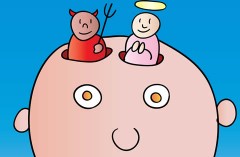The Rivalry in Your Customer’s Brain
 Simplistic explanations of consumer behavior abound. Push this button, trigger that emotion, pitch to a particular need, and people will buy. The decision making process is much more complex, of course. In Incognito: The Secret Lives of the Brain, David Eagleman includes a chapter that aptly sums up the ongoing conflict in our brains with its title: A Team of Rivals. Eagleman explains that many of our mental processes aren’t simple linear deductions, but rather a process of weighing conflicting inputs and priorities to arrive at a conclusion. That applies to interpreting our sensory inputs, making decisions, and more. When we say we are “of two minds” on an issue, we aren’t exaggerating and are often understating the case.
Simplistic explanations of consumer behavior abound. Push this button, trigger that emotion, pitch to a particular need, and people will buy. The decision making process is much more complex, of course. In Incognito: The Secret Lives of the Brain, David Eagleman includes a chapter that aptly sums up the ongoing conflict in our brains with its title: A Team of Rivals. Eagleman explains that many of our mental processes aren’t simple linear deductions, but rather a process of weighing conflicting inputs and priorities to arrive at a conclusion. That applies to interpreting our sensory inputs, making decisions, and more. When we say we are “of two minds” on an issue, we aren’t exaggerating and are often understating the case.
When Rats Can’t Decide
A simple example of a decision between competing interests is a classic experiment conducted by renowned psychologist and neuroscientist Neal Miller that demonstrated the approach/avoidance conflict. He measured how rats would balance a food reward against an electric shock, both of which would be received at the end of a chamber. Miller found that the rats would approach the food but “hover” at the point when their avoidance gradient (fear of being shocked) was in balance with their desire for food.
Shifting Rivals
Human decisions are rarely as simple as the well-balanced rodent conflict that resolved to a simple tug-of-war between two priorities: food and avoiding pain. Nevertheless, there are indeed similarities in the Team of Rivals concept. Eagleman notes that the two big players in our brain are the emotional and rational systems, which may fight directly: “Want it now!” vs. “Can’t afford it!” is a common conflict, but things can get more complex quickly. As I mentioned in Brain Fight: Who’s the Decider, a decision as simple as ordering dinner in a restaurant can involve everything from low-level desires (“Fat! Carbs! Want it!”) to logic (“The poached salmon would be healthy.”), and from unrelated emotions (“My date will find me more attractive if I spring for the lobster-for-two.”) to calculating (“At these prices, I should get the chicken.”). And, unlike the indecisive rat, humans can see the power of these factors can shift rapidly. A comment by a diner at the next table, a morbidly obese person squeezing by, a server’s enthusiastic recommendation, or seeing an amorous couple at the bar could all spike one or more of the warring factions and change the decision landscape. Even then, we may seem a little like the rodent subjects – haven’t we all “hovered” between dissimilar menu choices until the expectant gaze of the server forces us to make a decision?
Back a Winner
Eagleman covers a lot of ground in the Rivals chapter, but for me the neuromarketing takeaway is that there are no easy answers, and that even our best marketing efforts will simply rebalance the rivalry in our customer’s minds. A brilliant ad for an expensive vodka won’t cause everyone to buy it, but may elevate the “status seeker” in some consumers to the point where it wins over the “practical buyer,” who is busy remembering prices for other brands. In essence, when you plan your marketing campaign, you are deciding which rival to throw your support to. Picking a rival who is already strong (based on the consumer demographic, the venue where the product is sold, etc.) will maximize your chance for success. This is why fragrance companies, for example, sell sex appeal and not value. While there is no doubt a “value rival” present when a consumer is standing at the fragrance counter, it is unlikely to impact the final decision much except for extreme circumstances (like a product price that is exceptionally high, or an amazing deal on a well-regarded product). Rather, olfactory triggers and perceived “mating” attractiveness will overwhelm modest pricec differences. The lesson: be sure you “back a winner” with your marketing and advertising!
Amazon Link: Incognito: The Secret Lives of the Brain
Kindle: Incognito: The Secret Lives of the Brain
